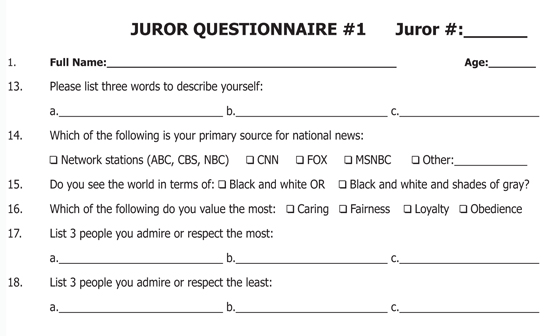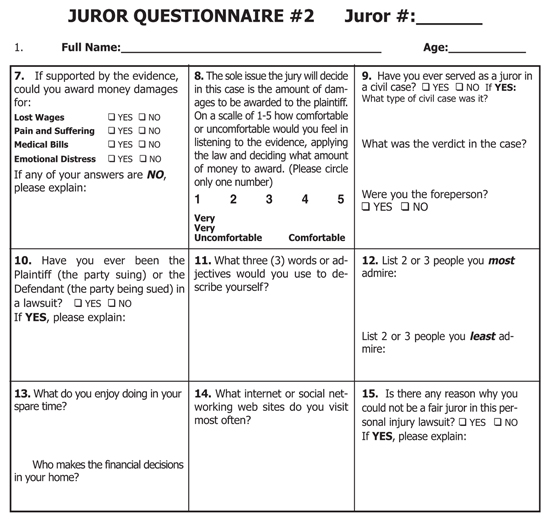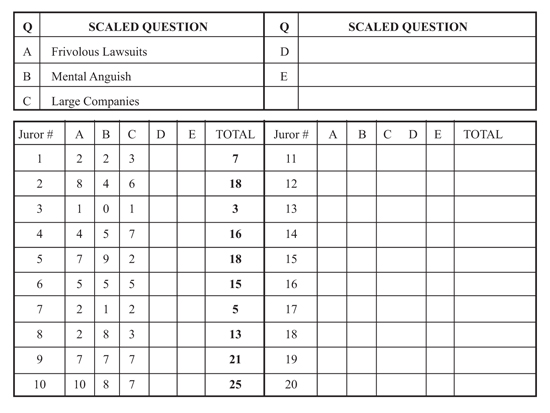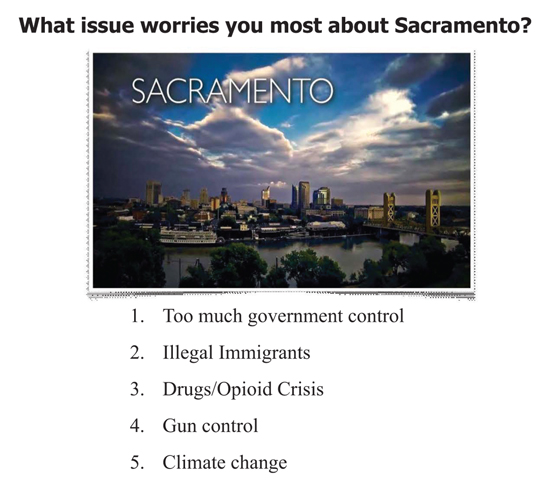Identifying and connecting with conservative jurors
There is a difference between “very conservative” jurors and “conservative” jurors
[This is part one of a two-part article. The second part will be published in a future issue of Advocate.]
Think about the typical jury panel in your venue. As you scan that sea of panel members, how many would identify themselves as conservative or very conservative? More importantly, how many would you identify as conservative or very-conservative jurors?
If you practice in a jurisdiction where you have more peremptory strikes than conservative panel members, you don’t need to read this article. For the other 99.9% of you, we think you will benefit from this article. This first part will help you identify the conservative jurors that you need to move for cause or remove with a peremptory strike. Not all Republican jurors are conservative or very conservative. You need to know more than their political party to identify all the conservative jurors.
Part two of this article will help you live, relate, and connect with the remaining conservative juror(s) on your jury.
So, take that liberal or moderate hat off, put your feet up, and get ready to look at the world of jurisprudence through the eyes of conservative jurors.
Very conservative versus conservative jurors
There is a difference between “very conservative” jurors and “conservative” jurors. The very-conservative juror lives in the world and messaging of Drudge Report and Breitbart News, while traditional conservative jurors get their national news from the likes of FOX, Sean Hannity, and Rush Limbaugh. There are a plethora of very conservative and conservative news outlets you should visit and review so you can appreciate the messages that conservative jurors are hearing every day.
The very-conservative juror leans heavily in the direction of tort reform and limiting the types of lawsuits that are legitimate. Conservative jurors accept most lawsuits but will tend towards the low end of damages. Both categories of jurors will presume that a personal-injury lawsuit that does not involve severe, permanent, or catastrophic injuries is frivolous. The difference is that conservative jurors can be persuaded in your direction if liability and damages are clear. Very-conservative jurors are virtually impossible to persuade – even if you do, they will award the least amount of damages that their mind can justify.
There are two vehicles for identifying the conservative and very-conservative panel members: (1) a few questions on a single-page questionnaire; or (2) using scaled questions during your voir dire. We explain both and give you some examples of questions that will quickly identify the conservative jurors on your jury panel.
The one-page juror questionnaire
Juror questionnaires are absolutely the best vehicle for obtaining information from members of your jury panel. You will learn more from a one-page juror questionnaire than you will ever learn in a day of attorney voir dire. Why? The reasons are simple: a one-page questionnaire typically contains 12-15 questions plus subparts. If you have a 40-person panel, it will take them no more than 20 minutes to fill out the one-page questionnaire, and it will take you or your team no more than an hour to extract the critical information.
Conversely, asking every single question to all 40 jurors would take hours. It would take at least 5 minutes to ask, and have every juror answer, each question (5 minutes × 40 jurors = 200 minutes) – more than 3 hours to obtain the same information! It would be incredibly boring for the other panel members and the judge if you were to ask each juror every question.
Most people feel really uncomfortable talking in a public setting, let alone in a court of law. The old adage is true: the fear of public speaking comes in ahead of the fear of snakes and death. So the questionnaire is the most practical and non-embarrassing way to get the information you need from every single juror.
To further eliminate the court’s concern about time delay and cost, after getting opposing counsel’s agreement and the court’s approval of the questionnaire, use a triplicate carbonless questionnaire. Most copy centers such as Kwik Kopy or FedEx Office can create these. Remember that copy centers will want 24 hours for the triplicate ink to dry, and you will need to bring clipboards and black ink ballpoint pens to court.
We are huge proponents of a one-page questionnaire. Judges and jurors prefer it while defense counsel would rather have lengthy and more thorough questionnaires. Remember this rule – one-page questionnaires benefit plaintiffs; two pages or more benefit defendants.
Sample juror questionnaires
The one-page questionnaire should include two or three opportunities for the jurors to give you insight into their value system. The easiest and most direct question would be: “Which of the following best describes you: Very Conservative, Conservative, Moderate, Liberal or Very Liberal.” This is a great way to identify your jurors. The problem is that most courts will not allow you to ask it either in a questionnaire or in court. However, there are other ways to get this information on a questionnaire. Some examples of relevant questions are contained in the two questionnaires included with this article (yes, we know some numbers are missing from the list). (See Juror Questionnaire 1)
In this example, the key opportunity questions ask the juror to share information about their self-reflection, life experience, and value system. Question 13 (self-reflection) will tell you the most about how they see themselves. The answers will help you determine whether the juror is favorable or unfavorable on liability and damages issues. The most adamant, conservative jurors will write words like conservative, cautious, traditional, loyal, or old-fashioned.
Question 14 is obvious. The key to this question is to make sure you ask about national news as opposed to the local stations that they watch. Question 15 is crucial for two reasons: (1) conservative jurors often tend to check the Black and White box; and (2) Black and White box jurors rarely award non-economic damages.
Finally, questions 17 and 18 must be asked in every personal-injury or wrongful-death case. Pay close attention to the information you receive. For example, if you are trying to figure out which family members should testify at trial and who should be in the courtroom, look at the answers the jurors gave to questions 17 and 18.
If you want to identify the conservative jurors, modify these questions to say, “List 3 politicians or public figures you admire or respect the [most/least].” The “admire most” list often includes Presidents Reagan or Trump, Arnold Schwarzenegger, Mitt Romney, Pete Wilson, Justice Antonin Scalia, Glenn Beck, William F. Buckley, George Will, Ann Coulter, Bill Kristol, Tucker Carlson, S.E. Cupp, Karl Rove, Laura Ingraham, Ben Shapiro, etc. The list of known conservative pundits, politicians and public figures is long and is getting longer. When a juror uses a name that you don’t recognize, look the person up. (See Juror Questionnaire 2)
This second format we use for our one-page questionnaires. We again ask the adjectives question (Question 13/Question 11) as well as the “admire most/least” questions (Questions 17-18/Question 12). We strongly recommend that you include these questions in every case where you want to use a questionnaire.
The key questions in this second example are 7, 8, and 14. Your conservative jurors will be inclined to answer no to Pain and Suffering and Emotional Distress (Question 7). Question 8 about award damages is a scaled question – you must compare the answer to this question with the answers to other questions.
Typically, very-conservative jurors will give an answer of 1 or 2. Our view is that if a juror answers 1 or 2 on a scaled question, that does not make them an automatic challenge for cause. Rather, such an answer should compel the lawyer to follow up with specific cause questions.
Conservative jurors, however, always consider themselves law-and-order folks. The fact that the question uses the phrase “applying the law” might cause a juror or two to circle the number 3. This is exactly why you must include other questions on the questionnaire to flush out and identify your conservative jurors.
The final question that might help identify the conservatives is question 14. Conservative jurors, like liberal jurors, will show their true leaning when they disclose what websites, blogs, podcasts, and other social media forums they visit regularly.
You can include lots of other questions in questionnaires. Questions that have been used for decades are still helpful in learning political slant. Examples include favorite TV shows, talk show hosts or newspaper columnists. Favorite bumper sticker is another classic question. Another way to ask the bumper sticker question is: “If you could put anything on a bumper sticker, what would it say?”
For many years, we have asked, “If the negligence of a company caused you or a loved one to be seriously injured, would you sue?” If any panel members answer, “No,” you now know two things: (1) they are very conservative; and (2) they will not find in your favor.
You need to find the two to three questions to put on the questionnaire that opposing counsel will agree to and the court will allow. You may be saying to yourself at this point, Lisa and Robert are from Texas and in that liberal state they may get a questionnaire, but here in California, my judge will not allow one. Remind the court of Code of Civil Procedure, section 222.5, subdivision (f), which states, “A trial judge shall not arbitrarily or unreasonably refuse to submit reasonable written questionnaires, the contents of which are determined by the court in its sound discretion, when requested by counsel. If a questionnaire is utilized, the parties shall be given reasonable time to evaluate the responses to the questionnaires before oral questioning commences.” (Code Civ. Proc., § 222.5, subd. (f).)
Persuade the judge to give your questionnaire a try, since: (1) the parties agree on a short questionnaire; (2) it will not slow down jury selection since no time is wasted on copying; and (3) counsel will not re-ask any questions already covered by the questionnaire, although you may have to follow up on some of the answers.
Using scaled questions during voir dire
Without a questionnaire, you need to get creative and prepare a jury selection PowerPoint. In almost every civil case we have worked on in the past few years in state court, the lawyers have used a PowerPoint as part of their voir dire. Depending on the case, the judge, the time allowed per side for voir dire, and the lawyer’s comfort level with PowerPoint, the number of slides range from one to dozens. You can use some of the questions we discussed previously from the questionnaires (e.g., source of national news or the “black and white” or “black, white and shades of gray” questions), but the best use of a PowerPoint slide deck is to ask scaled questions.
Here is an example of a slide that will identify your conservative jurors.
(See Blue-Hirschhorn-Sacramento)
This question will identify your pro-Trump jurors:
(See Blue-Hirschhorn-Trump-Wall)
These are just a couple of examples of the kinds of scaled questions and images you can use to identify the conservative jurors in the panel. Every single juror gives the number that best reflects their view or opinion on the statement or question you are asking. For a lawyer that has never employed this approach to jury selection, it might seem cumbersome and time consuming to have each and every juror answer a question. When done properly, it would only take 4-5 minutes to get each member of a 50-person jury panel to answer.
There are five keys to properly using scaled questions:
1. The questions must be simple and unambiguous;
2. Whatever scale you use (e.g., 1-5, 1-9, 0-10), make sure the worst answer is the lowest number and the best answer is the highest number for every question;
3. Do not let any of the panel members sidetrack you by trying to explain their answer. If you allow this even once, it will derail the entire process of collecting the answers efficiently and effectively.
4. Go slowly, say each juror’s name or juror number and have the jurors answer loud enough so everyone can hear the answer; and
5. Stay in numeric order when getting the numbers (answers) provided so you or the person helping you can keep track of the information.
We have developed a useful chart for keeping track of the answers to scaled questions. While the primary use of scaled questions is to quantify each juror’s views on key issues in the case, it has equal applicability and utility when it comes to determining the conservative and very conservative jurors.
PowerPoint slides
We have developed a set of PowerPoint slides that provides a variety of questions and images designed to target the group of jurors you want to identify. You will find these slides attached to this article at www.advocatemagazine.com. While many judges might not allow most of these questions, if you propose five of them, the judge might allow you to use one. At the very least, most judges are likely to allow slide 3 (Doctor’s office), slide 7 (more government regulation), and slide 10 (7th Amendment). It would be much easier and more efficient if judges would simply allow you to ask the fundamental and important question you really want the answer to – “What is your political slant?” – but until then, we’ve given you the tools to extract this critical information.
In the second part of this article, we will help you find the path to communicate with your conservative jurors. How you frame your issues, how you convey what your case is about, and how the jury can fix this problem.
Lisa Blue
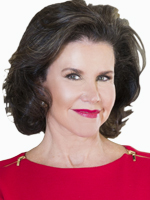
Lisa Blue, a lawyer with the Dallas firm Baron and Blue PLLC, received her undergraduate degree from the University of Georgia and two master’s degrees from the University of Virginia in Counseling Psychology. Ms. Blue’s accomplishments in trial courts nationwide have been widely recognized, including being named one of the Top 50 Women Litigators in the U.S. by the National Law Journal, Trial Lawyer of the Year by the Texas Chapter of the American Board of Trial Advocates, as well as receiving the Honorary Barrister Award from the University of Texas Law School and the Distinguished Alumni Award from South Texas College of Law. In April of 2015 Lisa was inducted into the Trial Lawyer Hall of Fame.
Robert Hirschhorn

Robert Hirschhorn is a lawyer and has been a jury and trial consultant for more than 30 years. In the five years since Robert assisted the defense in State of Florida v. George Zimmerman, Robert has had a modicum of success in picking juries.
Copyright ©
2026
by the author.
For reprint permission, contact the publisher: Advocate Magazine

